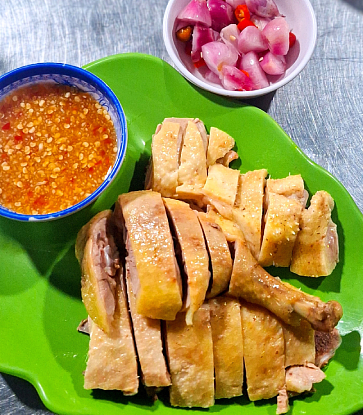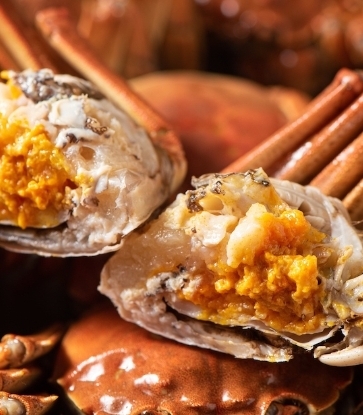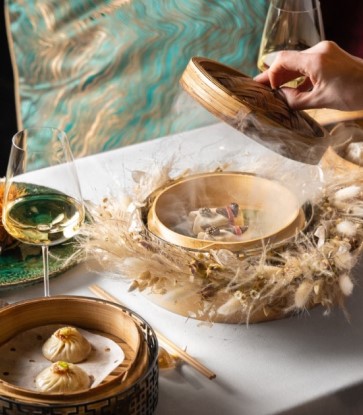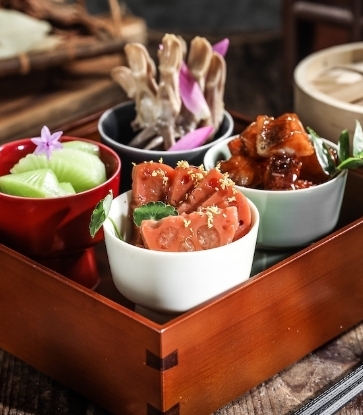From cooking methods to the size, style and origins of abalone, there are many intricacies involved in assessing the planet's most sought-after shellfish. Before you next face a full page of premium abalone dishes in a restaurant, we break down the topic for you with the help of expert chefs from MICHELIN Plate restaurants Yan Ting and Cherry Garden.
Long considered a delicacy among the Chinese, this expensive shellfish is served at banquets and is especially popular during Chinese New Year celebrations as its Chinese name, bao yu, means “guaranteed abundance”.
Abalone belongs to the gastropod (sea snail) family, alongside whelk and locos, which all have a single shell with an inner, iridescent layer. Whether steamed, pan-fried, braised, gently poached in soup or even enjoyed raw, the part of the abalone that is consumed is its muscular foot, which has a strong suction power that allows the abalone to clamp tightly to rocky surfaces, or onto the sides of a glass tank — as may be observed in Chinese restaurants.
See All The Chinese Restaurants In The MICHELIN Guide Singapore 2019

But unlike fish and lobster, live is not always best when it comes to abalones; it is the dried version that is most sought after for its deep umami flavour. And then there’s the usual flummox: do abalones actually have multiple “heads” and is fewer heads always better than more?
We ask Chef de Cuisine So Kam Lok of MICHELIN Plate restaurant Yan Ting of The St. Regis Singapore and Executive Chef Eric Tan of Mandarin Oriental, Singapore who oversees MICHELIN Plate restaurant Cherry Garden, for more insights into the delicacy.
Click Here To Book A Table At Yan Ting
Banner image: Braised South African Dried Abalone with Superior Oyster Sauce from Yan Ting (Photo: The St. Regis Singapore)

Chef So (left), who spent part of his career with the Ah Yat Abalone Group from Hong Kong (which runs the one-MICHELIN-star Ah Yat Harbour View), explains that the “number of heads per catty” refers to the size of one abalone, or specifically the number of pieces of abalone that would make up a catty (600g). For example, “2 heads in 1 catty” (600g) equates to two pieces of 300g abalone while 4-head in 1 catty (600g) refers to four pieces of 150g abalone. Hence, the larger the number, the smaller the abalone.
While this traditionally refers to the abalones that have been dried, it is also used to describe canned abalone. So when the menu lists a “heavier” 3-head abalone for a substantially lower price than a “lighter” 22-head abalone, there’s a catch.

A giveaway is when the “heavier” one is described in the menu as tang bao, or soup abalone, and the “lighter” one as tang xin gan bao, or sugar heart dried abalone, which are canned and dried abalones respectively. Xian bao refers to fresh abalones that could either be live or frozen.
Chef Tan (right) adds, “The higher the head count, the smaller and younger the abalone. There is no ideal size to look out for as it depends on personal preferences. However, in Chinese culture context, it is believed that consuming abalone will bring forth good fortune and a year of abundance so there are some who will opt for more “heads” of the abalone to signify an abundant year ahead.”
Why do wild caught abalones cost more?
Common varieties used in Chinese restaurants are the South African abalones; Green Lip, Brown Lip, Black Lip abalones from Australia; Blue Lip and Yellow Lip abalones from Mexico; and Kippin abalone from Japan, according to chef So.
If a restaurant lists the abalone as wild caught, it will also be priced substantially higher as they are very rare. According to the Food and Agriculture Organization of the United Nations, an estimated 95% of abalone supply worldwide are from farms all around the world such as South Africa, Australia, U.S. and China.
As abalones are slow growers, growing between 1-3cm a year, it takes at least four years to reach a marketable size of more than 9 cm. What contributes to the high price of wild caught abalones are fishing bans and physical risks divers have to subject themselves to when picking the shellfish from inside crevices and under boulders on rocky reefs.
Due to overfishing, illegal poaching and sustainability concerns, diners and restaurants have turned to farmed abalone which are cheaper and more easily available than wild abalone.

Do farmed abalone and wild caught ones taste different?
If the customer is concerned about sustainability, should they only choose the farmed abalone? Wild caught abalones have a stronger taste as compared to farmed abalone with more delicate flavour, says chef Tan, while farmed abalones tend to be softer and have more mild flavours.
Farmed abalones are the go-to if a customer is concerned about sustainability, as the population of wild abalones is almost on the brink of extinction caused by illegal poaching and overharvesting that render these gastropods insufficient time to naturally reproduce. Additionally, farmed abalones occupy a lower environmental footprint and the environmental conditions of such abalones can be artificially tweaked, leading to a higher and more sustainable yield, says chef So.

What are the differences between abalones from different countries?
Why do South African abalones have a reputation for being the most premium compared to those from other countries like Japan, US, Australia, New Zealand, Mexico, China, etc? Farmed and wild caught South African abalones are highly sought after, because they offer the best compromise between quality and price, according to chef So. The abalones have a larger size and a more distinct flavour and fragrance owing to the pristine marine environment in the cold waters off the coasts of South Africa.
For chef Tan, South African abalones are considered the most exquisite selection due to their distinctive fresh and rich flavour and succulent texture. They also weigh more and have a darker colour as compared to abalone from other regions, he explains. Golden yellow in colour, Japanese abalone are more chewy and have a smoother texture and strong aroma. Australian abalone are lighter in colour, smooth in texture, have a sweet taste and tender meat.
Is “Chilean abalone” or locos a type of abalone? How do you tell them apart?
Chilean abalone refers to locos, a type of sea snail or mollusk that look similar to abalone, but are not at all related. These mollusks, usually found along the coasts of Peru and Chile, feed on barnacles and mussels, and have a milder flavour and firmer texture as compared to their herbivore abalone counterparts, chef So points out. When sold, Chilean abalones are usually presented in slices in cans. Another key difference is the lower price of Chilean abalones is much lower.

As abalone is available fresh, frozen, dried and canned, which methods of cooking are most suited to each type?
Each type of abalone has its own unique characteristics in terms of its texture and flavour. Frozen and fresh abalones are most suited for grilling which allows the meat to soak in their own juices, or they can also be steamed ensuring nutrients are preserved and the natural sweetness of the shellfish shine through. Other alternative cooking methods include stir-frying and boiling in soups, says chef So. For chef Tan, the sweet taste of fresh abalone is best appreciated when it is served as sashimi with soy sauce and wasabi. It can also be served steamed or grilled.
Dried abalones are best used in soups as the stronger flavour profile of the shellfish lends a sweet and distinct flavour to the broth, according to both chefs. Alternatively, they can also be braised for long hours in oyster sauce.
With canned abalones, little preparation is required because most canned abalones contain salt or are already braised in a sauce, rendering a flavour to the meat. The texture differs depending on the preparation method of the shellfish. When eaten raw, the meat will have a crisp bite with a subtle mouthfeel, as opposed to a more genuine bite and firmer texture with a braised, boiled and stir-fried abalone. Stir-fried abalones are usually cut in strips against its grain before getting stir-fried, as this results in a meltingly tender meat, chef So recommends.
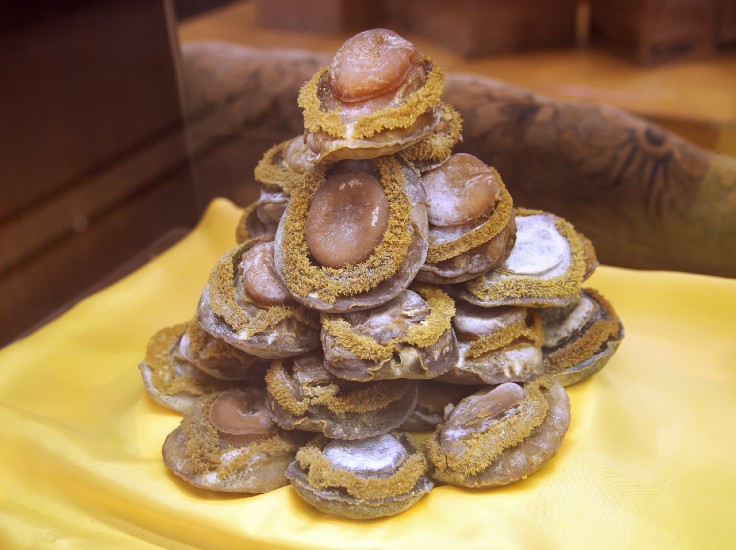
What is the best way to prepare dried abalones at home?
First, the shellfish has to be soaked in room temperature water and kept in a fridge for three to four days, says chef So. Then, scrub the abalone and remove the entrails. Soak in hot water for eight hours and repeat the step until soft. The hydrated abalone is ready to be cooked with other ingredients. For chef Tan, dried abalones should be soaked overnight prior to braising it as a whole. During the cooking process, the abalone is simmered in broth for several hours to soften it and thereafter served as a whole or in thin slices.
Are we more likely to see dried or live abalone in restaurants?
It is dependent on the individual restaurants based on the specialty dish they offer. Restaurants without live tanks will usually serve canned or dried selections of abalone, chef Tan points out. Canned and dried abalones are also popular among restaurants for their longer shelf life, as fresh abalones are highly perishable and should be consumed the same day. Additionally, storing fresh abalones in tanks requires meticulous handling, such as the monitoring of water quality in the tanks and adequate level of dissolved oxygen in the tank, chef So adds.

When you have the option to select abalones from a live tank in a Chinese restaurant, how does one assess what is a good and fresh abalone?
An abalone of good quality should be lively and has a tendency to attach itself hard to the side of the tank. Another indicator would be the movement of its foot muscle or a dent in the flesh when touched; the former indicates that it is alive while the latter occurs when it is dead, according to chef So.

Which abalone dishes would you recommend at your restaurants?
Braised South African 22-head Abalone with Superior Oyster Sauce at Yan Ting has a subtle sweetness of the South African abalone that comes through as it is braised for two hours in a robust stock of chicken feet, pork ribs and pigskin, chef So says. The dish is given a gentle lift with the addition of house made superior oyster sauce.
Cherry Garden’s signature prosperity dish Pen Cai, as well as the braised 4-head whole abalone with premium oyster sauce. The dishes are prepared using premium and sustainably sourced abalone, and various combination of herbs and ingredients are added to bring out the flavour profile of the abalone. The abalone is tenderised through slow-cooking while retaining its firm texture, says chef Tan.

For more abalone specials, menus and promotions, head to HungryGoWhere's HungryDeals page here.











